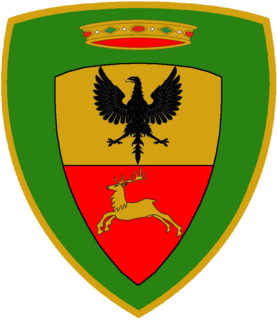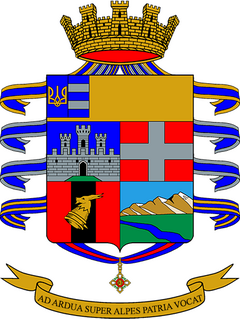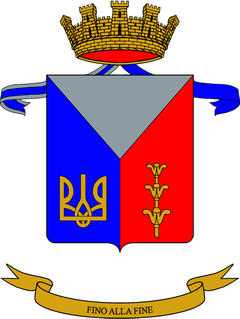Ana or ANA may refer to:

Ski warfare is the use of ski-equipped troops in war.

The Italian Army is the land-based component of the Italian Armed Forces of the Italian Republic. The army's history dates back to the unification of Italy in the 1850s and 1860s. The army fought in colonial engagements in China, Libya, Northern Italy against the Austro-Hungarian Empire during World War I, Abyssinia before World War II and in World War II in Albania, Balkans, North Africa, USSR and Italy itself. During the Cold War, the army prepared itself to defend against a Warsaw Pact invasion from the east. Since the end of the Cold War, the army has seen extensive peacekeeping service and combat in Afghanistan and Iraq. Its best-known combat vehicles are the Dardo infantry fighting vehicle, the Centauro tank destroyer and the Ariete tank and among its aircraft the Mangusta attack helicopter, recently deployed in UN missions. The headquarters of the Army General Staff are located in Rome opposite the Quirinal Palace, where the president of Italy resides. The army is an all-volunteer force of active-duty personnel.

The Alpini are the Italian Army's mountain infantry speciality. Part of the army's infantry corps, the speciality distinguished itself in combat during World War I and World War II. Currently the active Alpini units are organized in two operational brigades, which are subordinated to the Alpine Troops Headquarters. The Alpini's name comes from their inceptive association with the Alps, the mountain range that Italy shares with France, Switzerland, Austria, and Slovenia. An individual soldier of the Alpini is called Alpino.

The Royal Italian Army, also known as the Regio Esercito, was established during the proclamation of the Kingdom of Italy. During the 1800s Italy started to unify into one country and in 1861, Manfredo Fanti signed a creation decree which created the Army of the Two Sicilies. This newly created army first task was to defend against the repressive power in southern Italy. The Army of Two Sicilies combated against criminals and other armies during this time of unification. After the monarchy ended, the army changed its name to become the Italian Army.

The 2nd Alpini Regiment is a regiment of the Italian Army's mountain infantry speciality, the Alpini, which distinguished itself in combat during World War I and World War II. The regiment was disbanded in 1943 due to losses on the Eastern Front, however one of its component battalions, the Saluzzo Battalion, was reformed in November 1945 after the end of hostilities in Europe. The regiment itself was reformed in 1963 as a training unit, but during the 1975 army reform it was disbanded once again. In 1992 the regiment was raised once again and today it consists of the Saluzzo Battalion, is based in Cuneo and part of the Alpine Brigade "Taurinense".

The 1st Alpini Regiment is an inactive regiment of the Italian Army's mountain infantry speciality, the Alpini, which distinguished itself in combat during World War I and World War II.

The Alpine Brigade "Cadore" was a light Infantry brigade of the Italian Army, specializing in mountain warfare. Its core units were Alpini, the mountain infantry corps of the Italian Army, that distinguished itself in combat during World War I and World War II. The brigade was based in the Italian provinces of Belluno and Vicenza with its headquarters Belluno. The brigade was disbanded in 1997.

The Alpine Brigade "Orobica" was a light Infantry brigade of the Italian Army, specializing in mountain warfare. Its core units were Alpini, the mountain infantry corps of the Italian Army, that distinguished itself in combat during World War I and World War II.

The Alpine Brigade "Taurinense" is a light Infantry brigade of the Italian Army, specializing in Mountain Combat. Its core units are Alpini, the mountain infantry corps of the Italian Army, that distinguished itself in combat during World War I and World War II. The brigade's name "Taurinense" alludes to the Roman name Augusta Taurinorum for the city of Turin around which the brigade is based. Accordingly the brigade's coat of arms is modeled after Turin's coat of arms. The brigade carries on the name and traditions of the 1st Alpine Division "Taurinense".

The Alpine Brigade "Tridentina" was a light Infantry brigade of the Italian Army, specializing in mountain warfare. Its core units were Alpini, the mountain infantry corps of the Italian Army, that distinguished itself in combat during World War I and World War II. The Alpine Brigade "Tridentina" carried on the colours and traditions of the WWII 2nd Alpine Division "Tridentina".

The 9th Alpini Regiment is a regiment of the Italian Army's mountain infantry speciality, the Alpini, which distinguished itself in combat during World War I and World War II. Based in the city of L'Aquila in Abruzzo the regiment is operationally assigned to the Alpine Brigade "Taurinense".
The Alpini Paratroopers Battalion "Monte Cervino" is the sole battalion of the Italian Army's 4th Alpini Paratroopers Regiment, which is one of the Italy's special forces units. The regiment is based in Verona in Veneto and assigned to the Army Special Forces Command. The Alpini are a mountain infantry corps of the Italian Army that distinguished itself in combat during World War I and World War II. To this day, this is the only unit of "mountain paratroopers" in the world.

The National Alpini Association is an Italian association representing the "Alpini in congedo" of the Italian Army. The Alpini are a mountain infantry corps of the Italian Army, that distinguished itself in combat during World War I and World War II. As the ANA defines itself a quick reaction reserve corps to the active Alpini units, it has been nicknamed 10th Alpini Regiment. Accordingly, the Italian Army never had a 10th Alpini Regiment.

The Alpini are a mountain infantry corps of the Italian Army, that distinguished itself in combat during World War I and World War II. In addition they are also famous in Italy for their songs and choirs.

The Comando Truppe Alpine or COMTA commands the Mountain Troops of the Italian Army, called Alpini and various support and training units. It is the successor to the 4º Corpo d'Armata Alpino of the Cold War. The Alpini are light Infantry units specializing in Mountain Combat. The subordinate units of the COMTA distinguished themselves during combat in World War I and World War II.

The 32nd Engineer Regiment is a military engineer regiment of the Italian Army based in Fossano in Piedmont. Raised on 24 September 2004 it is the youngest engineer regiment of the Italian Army and specializes in mountain combat. Its name was chosen to commemorate the XXXII Sapper Battalion, which fought in the Western Desert Campaign of World War II, while the regiment's only battalion, the XXX Sappers Battalion, fought in the Italian campaign on the Eastern Front. Since its reformation on 1 September 2002 as 32nd Engineer Battalion the unit has been part of the Alpine Brigade "Taurinense". Together with the other units of the Taurinense the regiment shares the right to wear the distinctive Cappello Alpino.

The Cappello Alpino is the most distinctive feature of the Italian Army's Alpini troops uniform. The Alpini are light Infantry troops, specializing in mountain combat. Initially the Cappello was only issued to the Alpini, but soon the Cappello was adopted by the Alpini Corps' support units like Artillery, signals, engineers. Today the Cappello is issued to members of 15 Army regiments, 3 battalions and various high commands. Thanks to the black raven feather, which is carried on each Alpini soldiers Cappello, the Alpinis are known as Le Penne Nere in Italy. A nickname the Alpini quickly adopted for themselves.

Signore delle cime is a popular Italian song of prayer. It was written by Bepi De Marzi in 1958, when he was 23 years old: he dedicated the song to his friend Bepi Bertagnoli who died in 1951 while climbing Mount Piatta in the upper Valle del Chiampo.

The 182nd Armored Infantry Regiment "Garibaldi" is an inactive unit of the Italian Army last based in Sacile in Friuli Venezia Giulia. The regiment was part of the Italian army's infantry and was last operationally assigned to the Infantry Division "Folgore". The regiment was an atypical unit of the Italian Army: formed without a sister regiment from partisan formations it was the only infantry regiment to be formed by the army after World War II and was the only unit, whose members wore a red tie with their formal uniform.